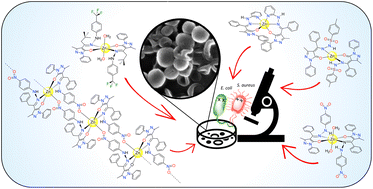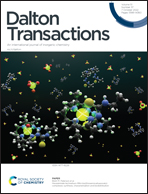Role of hydrazone substituents in determining the nuclearity and antibacterial activity of Zn(ii) complexes with pyrazolone-based hydrazones†
Abstract
Hydrazones and their metal derivatives are very important compounds in medicinal chemistry due to their reported variety of biological activities, such as antibacterial, antifungal and anticancer action. Five hydrazone-pyrazolone ligands H2Ln (n = 1–5) were prepared and fully characterized and their tautomerism was investigated in the solid state and solution. Five zinc(II) complexes 1–5 of composition [Zn(HLn)2] (n = 1 and 2), [Zn(HLn)2(H2O)2] (n = 3 and 5) and [Zn(HL4)2]n were synthesized and characterized by elemental analysis, IR, 1H, 19F, 13C, and 15N NMR spectroscopy, and ESI mass spectrometry. In addition, the structures of two ligands and three complexes were determined by single-crystal X-ray diffraction. The ligands H2L2 and H2L4 exist both in the NH,NH tautomeric form. Complexes 1 and 2 are mononuclear compounds, while complex 4 is a one-dimensional coordination compound. Density functional theory (DFT) calculations were carried out on proligands, their anions and all zinc complexes, confirming the experimental results, supporting IR and NMR assignments and giving proofs of the mononuclear diaqua structure of complexes 3 and 5. The antibacterial activity of the free ligands and the Zn(II) complexes was established against Escherichia coli and Staphylococcus aureus, and a strong efficiency has been found for Zn(II) complexes, particularly for the polynuclear 4 and the mononuclear diaqua complex 5, the latter containing a ligand with aliphatic and fluorinated substituents able to compromise the permeability of and disrupt the bacterial cell membrane.



 Please wait while we load your content...
Please wait while we load your content...